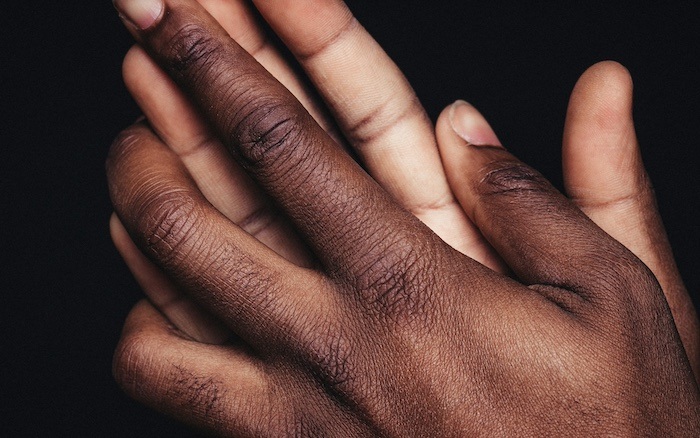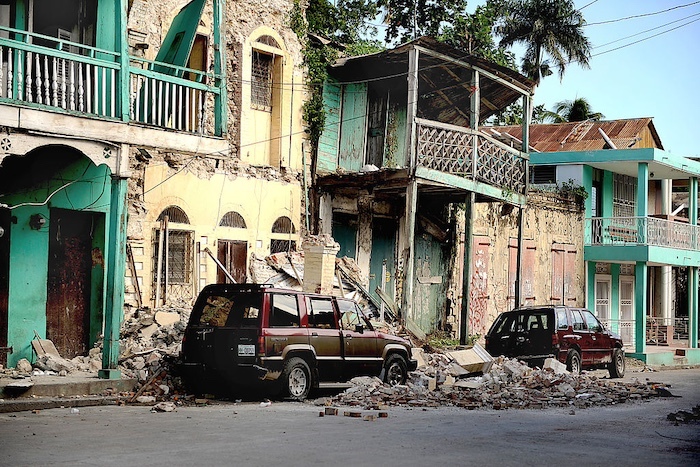From Haiti, a Powerful Story of Disaster and Connection
Posted on May 14, 2024

This Haitian Heritage Month, we’re glad to bring you a story about love and hope after devastation. Written in the immediate aftermath of the Haitian earthquake of 2010, Évelyne Trouillot’s “Primal Needs” introduces us to two characters who would typically be separated by many life circumstances—age, economics, social position—suddenly finding themselves trapped together in the earthquake’s wreckage. Their unlikely connection is the heart of the story.
“Primal Needs” is inspiring specifically because of its tight grip on reality—both the physical realities of what happens during an earthquake, and the reality of the larger society around the two characters, the son of a wealthy family and a woman who works as a maid who works in a neighboring house. Disaster may seem briefly to level social and cultural boundaries, but feelings of unity tend not to last; what the woman calls “the natural order” quickly reasserts itself. The bond between the woman and the boy is as delicate and fleeting as the landing of two butterflies he observes in the story’s first line:
They arrived together, a pair of butterflies with green and yellow wings, dappled and tremulous.
It is, however, meaningful, and perhaps even more a natural part of human nature than the “natural order” of society. As the earthquake begins, the boy notices in himself “the powerful instinct that drew him toward other humans in this universe where objects seemed to follow inscrutable laws and act in defiance of people.” This impulse could be one of the primal needs to which this story’s title alludes, giving rise to an intense physical desire, “gentle as the fluttering wings of the butterflies.”
Although the couple separates at the story’s end, their shared experience may be transformative, especially to the boy, who is the last to let go of their clasped hands. That potential for meaningful change based on a shared bond is what makes this story authentically inspiring, even as Haiti moves through another difficult period. “Primal Needs” reminds us that the urge to connect is integral to our humanity.
Behind the Story

This story describes the aftermath of an actual, devastating earthquake that occurred in Haiti in 2010, killing more than 250,000 people and causing massive destruction. Évelyne Trouillot wrote “Primal Needs” only days later. To learn more about the earthquake, students and educators can:
- Read coverage in the Guardian.
- Look at photos from Canadian photographer Ivanoh Demers (mentioned in another piece about the earthquake published in WWB)
- Watch an author interview recorded one year after the earthquake, in which Trouillot responds to the question: “When there are so many needs out there, basic needs . . . why write?” (1:55–5:00)
“Primal Needs” in the Classroom
In addition to sharing some or all of the contextualizing resources above, educators might have students collaborate in small groups to trace the relationship between the two characters over the course of the story: before, during, and after their days of being trapped.
Guiding questions to scaffold that work, if needed, might include:
- What do the woman and “the son of the house” think of each other at the beginning of the story?
- What changes, and why?
Then, students can discuss the story’s ending in either the small groups or one comprised of the entire class:
- “She was the first to let go, and she walked away from him without a backward look”—why is that so?
- What do you think these characters will do if/when they see each other again?
Pairs Well with . . .
This story pairs well with contemporary writing from other parts of the world, as well as several classics.
On Words Without Borders:
- The “Fingers” section of an excerpt from the Booker Prize–winning Omani novel Bitter Orange, depicting love across social class: “Just imagine, Zuhur, imagine! My sister . . . my very own sister, marrying that peasant!” (Blog post about teaching the story)
- Two stories in which people fail to connect across a divide: “Detour,” also from Évelyne Trouillot (link to full text in blog post), and “The Pharaohs of Egypt,” a comic about Bedouin guides and tourists
- “Dori and Jina,” a postapocalyptic love story from Korea, in which two girls come together despite an atmosphere of fear and mutual suspicion
- “Love’s Labor,” a Chinese story about street vendors, love, and divisive rumors
Elsewhere:
A few of the many literary works depicting love across class, culture, time and space:
- A monologue in which an American girl falls in love with a figure from Haitian history, from Ntozake Shange’s “choreopoem” For Colored Girls Who Have Considered Suicide / When the Rainbow Is Enuf
- Shakespeare’s Romeo and Juliet
If You Come Softly by Jacqueline Woodson, a contemporary take on the Romeo and Juliet story
Potential Assignments:
Creative writing: Write a story about two people with a key difference between them: age, economic status, etc. Create a situation that somehow brings them together. What happens next?
- Story/Essay: Imagine what might happen in an encounter between the woman and “the son of the house” after the story’s ending. You can choose how and when the characters next see each other. It might be a week, a year, or even ten or fifteen years after the earthquake. The two might meet in the neighborhood where “Primal Needs” is set, or in a different part of the city like the community center the Trouillot family started after the earthquake (see the video interview above). Use evidence from the text and informational resources about Haiti to inform your work.
By Nadia Kalman, with additional writing and research from Maggie Vlietstra



